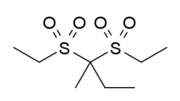Trional
Trional (Methylsulfonal) is a sedative-hypnotic[1] and anesthetic drug with GABAergic actions. It has similar effects to sulfonal, except it is faster acting.[2]
 | |
 | |
| Clinical data | |
|---|---|
| ATC code |
|
| Legal status | |
| Legal status |
|
| Identifiers | |
| |
| CAS Number | |
| PubChem CID | |
| ChemSpider | |
| UNII | |
| CompTox Dashboard (EPA) | |
| ECHA InfoCard | 100.000.858 |
| Chemical and physical data | |
| Formula | C8H18O4S2 |
| Molar mass | 242.35 g·mol−1 |
| 3D model (JSmol) | |
| |
| |
| | |
History
Trional was prepared and introduced by Eugen Baumann and Alfred Kast in 1888.[3]
Appeared in Agatha Christie's "Murder on the Orient Express", "And Then There Were None" and other novels as a sleep inducing sedative, and in In Search of Lost Time (Sodom and Gomorrah) by Marcel Proust as a hypnotic. Sax Rohmer also references trional in his novel Dope.
gollark: Plus a U+202E.
gollark: We could add triple backticks to make Discord unable to embed the name too.
gollark: ```/\$$^π*'"><[]{})@`[NUL BYTE]%+```or something.
gollark: We should make an esolang with a name with so many special characters that no wiki or website will be able to name it.
gollark: I remember one time I made an int subclass supporting all operations but horribly mucked up in exciting ways.
See also
- Sulfonal
- Tetronal
References
- (1907). Merck's 1907 Index. N. Y.: Merck & Co., p. 448.
- Sajous, Charles E. (1896). Annual of the Universal Medical Sciences
Philadelphia: F. A. Davis, v. 5, p. A-156. - Drinkwater, H. (1924). Fifty years of medical progress, 1873-1922.
New York: The Macmillan Company, p. 40.
This article is issued from Wikipedia. The text is licensed under Creative Commons - Attribution - Sharealike. Additional terms may apply for the media files.